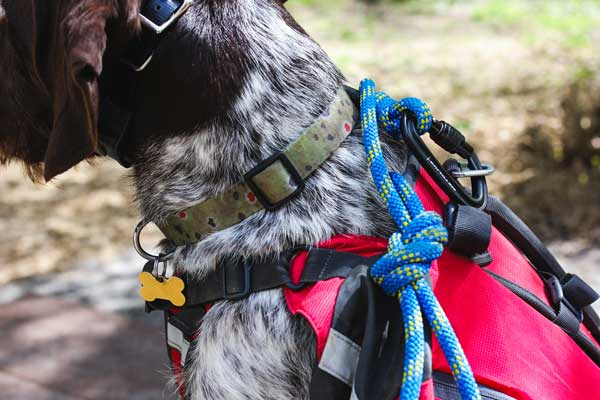
Hi there! We’re Parker Feierbach and Cherefawn Chang, Lennon’s owners. We’re here to write a short series on trail safety for everyone to read and learn from. As Mountainsmith’s K9 Ambassador, we’d have Lennon write it, but he has a pretty short attention span and no thumbs, so here we go!
For even the smallest hike, we divide our basic hiking needs into three categories:
- Monitoring your dog’s health
- Understanding water awareness
- Following trail etiquette
Today, let’s talk about dog health on the trail.
Keeping Your Dog Healthy on the Trail
1. Monitor their paws.
You should pay attention to your dog’s health prior to starting your adventure together. Check their paw-pads for any cracks or peeling. After the hike, check for the same on their pads, as well as any abrasions due to thorns or anything that might have become lodged between their toes. It’s also important to keep your dog’s nails trimmed to a medium length for their comfort and safety when hiking, and to prevent the risk of their nails splitting if you’re on coarse or rocky terrain.

2. Warm up the pup.
Just as you would before you take a good hike, get warmed up with a mile or so into the hike. As your hike is ending, be sure to have a cool-down period by slowing decreasing the intensity of exercise. If you have a clumsy or overly adventurous dog who is prone to falling, check their mobility after a fall to identify any potential injury.
3. Prepare for injury.
One of the most important things that we bring with us on our backcountry trips is a first aid kit. This includes items such as tweezers, bandages, chlorhexidine (antiseptic) wipes, wound seal (superglue is always a good thing to have on hand if nothing else) and Benadryl for swelling. Our kit also has the contact information and directions to the nearest emergency vet. That way, if anything was to happen, we do not need to spend time waiting on cell service or searching for a hospital.
Make sure your dog is up to date on all vaccines and on the proper prevention (heartworm, flea, tick). Annual or semi-annual wellness exams are very beneficial in maintaining your dog’s health as well as catching any ailments early. It is always a good idea to microchip your dog incase he runs off and you can’t find him after hours of searching. Of course, the most important first step is making sure you have a collar with your name, address and phone number, as well as another tag with their veterinary information in case of emergency.

4. Recognize your dog’s fitness level.
Be rational about your dog’s fitness to do the trail you’ve chosen. Certain breeds do not have the same energy level or endurance as others. Also, non active or overweight dogs will need to build up their athleticism before starting any intense activity.
5. Understand how your dog is feeling.
Maintaining a healthy dog is important, especially in the wilderness where a vet is not readily available. I can’t tell you how many times we’ve been ready to go and have looked at Lennon while standing at the door, realizing that he’s still not feeling well. If you wouldn’t go out and hike sick, your dog probably wouldn’t want to either, but they’d never let you understand that outright. Pay attention to your dog, understand the signs that they aren’t feeling well, both before, during and after being on trail.
That’s it for part one! Next time, we’ll focus on water awareness and trail etiquette. Follow @lennon_official for more photos and click here for more info on Lennon’s K9 pack.
- “Okay bye see you next time.” – Lennon

I’ve tried hiking but haven’t tried doing it with a dog. I guess it is advantageous to bring your pet along. Dogs are very good at tracking, so whatever happens along the way, it can greatly help.
Thank you so much for the tips. I never though about and everything mean sense. Now I have to get this tips for our next hike with my 3 dogs…